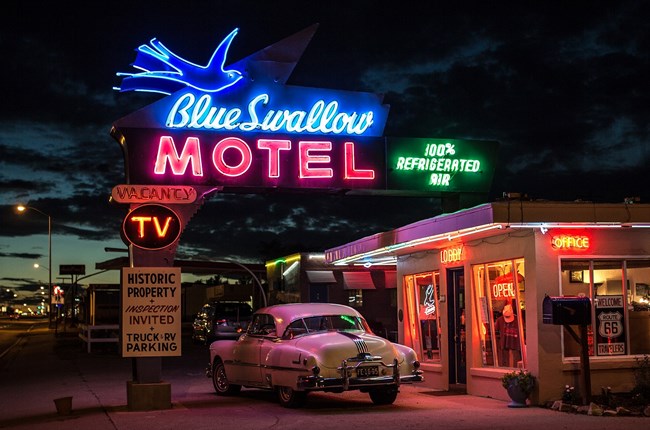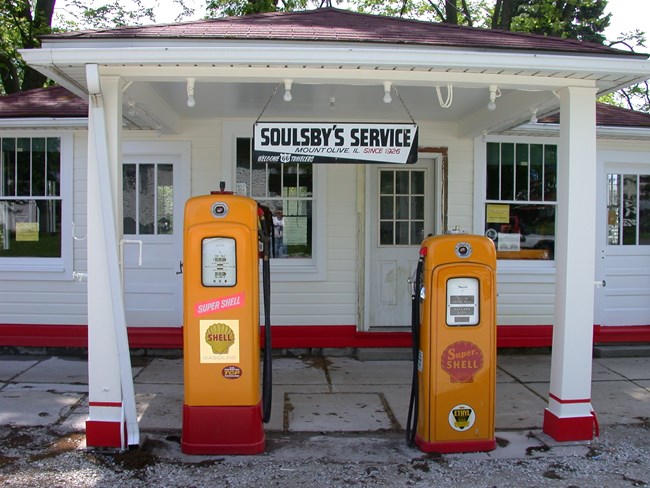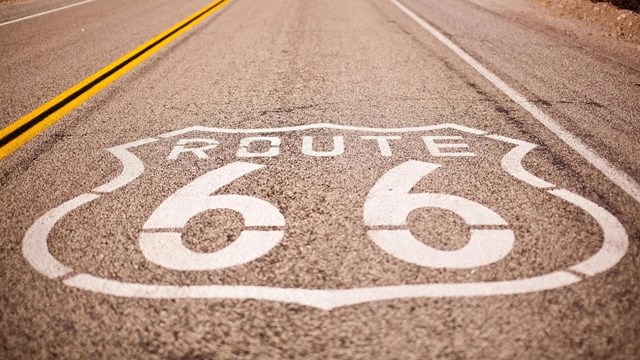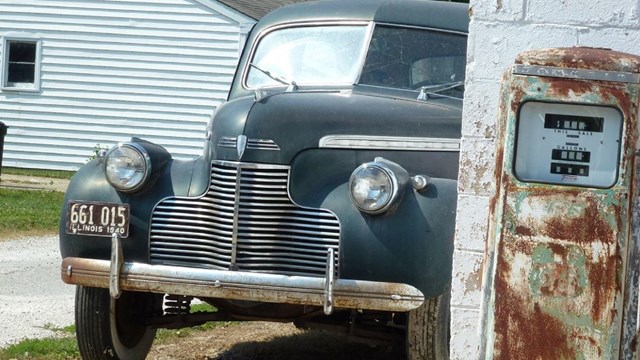Part of a series of articles titled Travel Route 66: Essay Series .
Article
4. Postwar Years: 1945 - 1960

By Sylvain L., CC BY 2.0, https://commons.wikimedia.org/w/index.php?curid=80150598
The social dislocation and uprooting of millions of Americans that began during the Great Depression and continued through World War II did not abate with the surrender of Germany and Japan. After the war, Americans were more mobile than ever before. Thousands of soldiers, sailors, and airmen who received military training in California, Arizona, New Mexico, Oklahoma, and Texas abandoned the harsh winters of Chicago, New York City, and Boston for the "barbecue culture" of the Southwest and the West. For many, Route 66 facilitated their relocation.
One such emigrant was Robert William Troup, Jr. of Harrisburg, Pennsylvania. Bobby Troup, former pianist with the Tommy Dorsey band and ex-Marine captain, penned a lyrical map of the now famous cross-country road. The words of his song, "get your kicks on Route 66," became the catch phrase for countless motorists, who moved back and forth between Chicago and the Pacific coast. One scholar likened the popular recording released in 1946 by Nat King Cole one week after Troup's arrival in Los Angeles to "a cartographic ballad." Bobby Troup's musical rendition provided a convenient mental road map for those who followed him west.
During the postwar decades, the population shift from "Snowbelt" to "Sunbelt" reached its zenith. Census figures for these years revealed population growth along Route 66 ranging from 40% in New Mexico to 74% in Arizona. Because of the great influx of people during the war years, California claimed over half of the total population of the West between 1950 and 1980.
The demographic disruption that began in the 1930s continued to stimulate roadside commerce. Storeowners, motel managers, and gas station attendants recognized early on that even the poorest travelers required food, automobile maintenance, and adequate lodging. Just as New Deal work relief programs provided employment with the construction and the maintenance of Route 66, the appearance of countless tourist courts, garages, and diners promised sustained economic growth after the road's completion. While military use of the highway during wartime ensured the early success of roadside businesses, the demands of the new tourism industry in the postwar decades gave rise to modern facilities that guaranteed long-term prosperity.

Historic Shell Station gas pumps. Illinois Route 66 Heritage Project, https://commons.wikimedia.org/w/index.php?curid=686653
The roadside architecture along U.S. Highway 66 illustrates the evolution of these facilities. Most Americans who drove the route did not stay in hotels; they preferred accommodations more convenient for automobile travelers. Motels evolved from earlier features of the American roadside such as the auto camp and the tourist home. The auto camp developed as townspeople along Route 66 roped off spaces in which travelers could camp for the night. Camp supervisors, some employed by the various States, provided water, fuel wood, privies or flush toilets, showers, and laundry facilities free of charge. Camp Joy near Lebanon, Missouri and Red Arrow Campground in Thoreau, New Mexico are examples of auto camps that have survived to the present day. The successor to the auto camp was the tourist home, which provided many of the same amenities but with the added feature of indoor lodging in the event of inclement weather.
The natural outgrowth of the auto camp and tourist home was the cabin camp, sometimes called cottages, which offered minimal comfort at affordable prices. Many of these cottages are still in operation. Eventually, auto camps and cabin camps gave way to motor courts or motels with all of the rooms under a single roof. Motor courts offered additional amenities such as adjoining restaurants, souvenir shops, and swimming pools. An estimated 30,000 motor courts or motels were in operation along the nation's many highways in 1948. Some of the more famous still associated with Route 66 are the El Vado and the Zia Motor Lodge in Albuquerque, New Mexico and the Coral Court in St. Louis, Missouri. The Wagon Wheel Motel in Cuba, Missouri; and Wigwam Village Motel #6 in Holbrook, Arizona still offer travelers the experience of what it was like to stop for the night on the Mother Road.
In the early years of Route 66, service station prototypes developed regionally through experimentation, then spread across the country. Gas stations had distinct buildings clearly associated with a particular petroleum company. Most started as simple house-like buildings with one or two service pumps in front and grew to larger, more elaborate stations complete with service bays and tire outlets. Soulsby's Shell Station in Mount Olive, Illinois and the Tower Fina Station in Shamrock, Texas are outstanding examples of the evolution of gas stations along Route 66.
Route 66 and many of the points of interest along the way were familiar landmarks by the time a new generation of postwar motorists hit the road in the 1960s. Many drew upon memories from excursions with their parents in the 1940s and 50s. World War II transformed the American public from a predominantly agricultural-industrial laboring class to an urban-technological society with increasing leisure and recreational time. American tourists' fondness for automobile travel and their enjoyment of sightseeing made them ideal targets for the service industries that cropped up along Route 66. A growing fascination with American Indian cultures led to increasing commercialization as public highways penetrated once inaccessible reservations. Interest in American Indians and the scenic, geologic, and historic wonders protected by the National Park System lured countless sightseers. To the average motorist during the post war period, a trip down Route 66 was an adventure through mainstream America accentuated by mom-and-pop motels, all-night diners, Indian curio shops, and far-too-infrequent restroom facilities.
More Route 66 Resources

Discover the hotels, gas stations, restaurants, and more than lined this iconic roadway.

Visit the Route 66 Preservation Program website to learn more about this historic roadway.
Last updated: May 5, 2020
